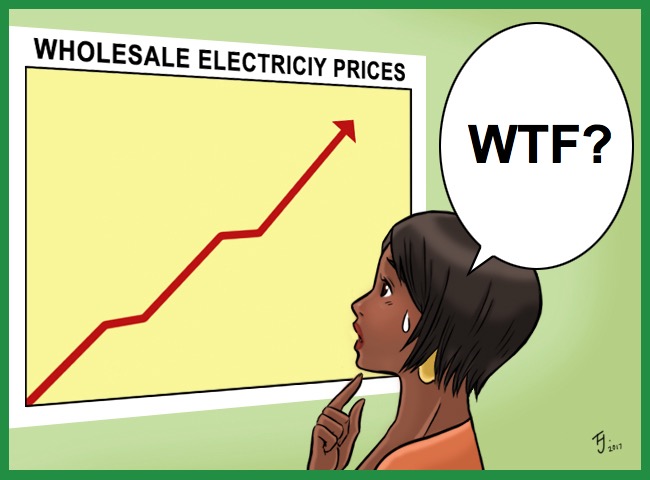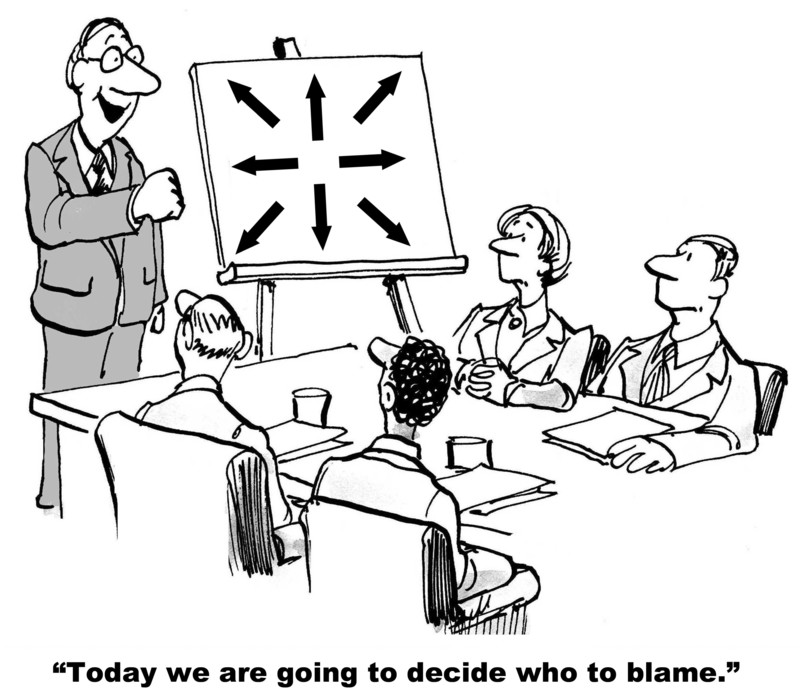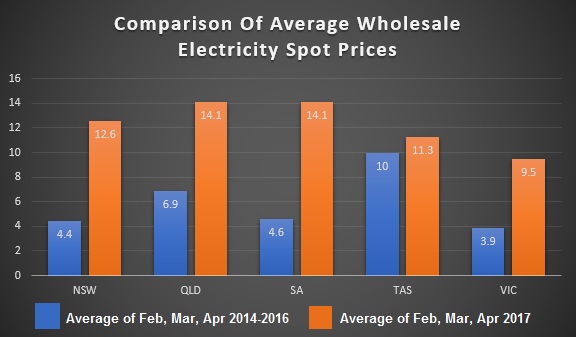
Is the rising electricity price really all down to gas prices?
Last week I wrote about how electricity prices in Australia are about to shoot so high the International Space Station will have to take evasive action. It appears it’s not enough for the electricity sector to make Australians pay ridiculous prices, they are going to force us to go right to ludicrous.https://www.youtube.com/watch?v=oApAdwuqtn8
You may say:
But Ronald, you’ve already covered this!
You told us how much electricity prices will go up by — Roughly 20%.
When it will start — July for most states and it’s already underway in Victoria.
How long it will take — 2 to 3 years.
Who will get off relatively lightly — Hopefully the Northern Territory, Tasmania, and the ACT.
Who will cop it in the neck — NSW with a possible 25% increase in household electricity bills.
And how to avoid paying through the nose — Own or install a good sized rooftop solar system.
So why are you bringing it up again? Don’t we already know everything we need to?
And I’ll respond by saying we’ve hardly started! We haven’t even done the most important thing! Or at least, the most important thing according to politicians and the media, which is deciding who to blame.
The good people who govern our country and also those who own our newspapers and TV stations, don’t like complex, messy explanations which involve multiple causes and accurately reflect reality. They like to pick one thing and run with it and not be too concerned if important information, nuance, or truth itself is lost along the way.
So politicians and pundits have cast around for something suitable for soundbites they can blame for the increase in electricity prices. I’m sure the Coalition would have been happy to pin it all on renewable energy, but that would be too much of a stretch even for them.
Fortunately, they found an almost perfect suspect and the villain of the piece was declared to be rising natural gas prices. The spot price of natural gas has more than tripled from what it was six years ago, which makes it a very plausible explanation for increasing electricity prices. And when specific details are required, they can say the hope that household electricity bills would not become ludicrous was killed by Santos, in Queensland, with a natural gas export terminal.
But the problem with this narrative is that because Australia only generates 8.2% of its electricity from natural gas, the tripling of natural gas prices by itself is only enough to directly increase residential electricity bills by around 3% and not the 25% that may happen in NSW. As natural gas often sets the price that is paid to all generators an increase in its price can have an disproportionate effect on electricity prices, but not an extra 25% effect. That’s just nuts.
So while increased natural gas prices do bear their share of responsibility, the amount of blame assigned to them by politicians and the media is out of proportion to their effect and this has allowed the other culprits to remain hidden from the public’s view. And because gas prices are only one factor, even if Prime Minister Turnbull’s much publicized intervention in the gas markets is wildly effective it will only reduce and not stop the electricity price increases that are to come.
Increased Gas Prices Have Little Direct Effect On Prices
Australia used to have the lowest natural gas prices in the developed world, but once gas from eastern states started being exported to Asia, prices launched themselves skyward as they approached international levels.
In 2011 the average wholesale spot price of natural gas in Australia was around $3.20 a gigajoule1. So far this year it has averaged around $10 a gigajoule. That means the price has more than tripled from less than 6 years ago, so we’re really paying through the nose or whatever orifice applies for gas.
But because only one twelfth of Australia’s electricity is produced from natural gas, the price increase alone is only enough to directly raise the average cost of generating electricity by around 0.7 cents2.
Higher Gas Prices Indirectly Boost Wholesale Electricity Prices
Currently coal power supplies 77% of Australia’s grid electricity and generally bids a relatively low asking price into wholesale electricity markets. Wind and solar farms, which supply 5.8% and 0.3% of grid electricity, normally don’t bid at all and just take the price that is set by other generators. Rooftop solar which supplies around 2.7% of Australia’s electricity isn’t included in the wholesale electricity market. The end result is that gas at 8.2% of supply and hydroelectricity at 8.3% often determine the wholesale price of electricity.
Natural gas determines the wholesale electricity price during periods when it both bids higher than other sources of generation and its output is required. Under these circumstances all generators supplying electricity are paid the same as the natural gas generator that bid in the highest price and has its output used. Because gas generators will always bid at least as much as what their fuel costs them an increase in natural gas prices can have a disproportionate effect on wholesale electricity prices.
Higher Natural Gas Prices Aren’t A Sufficient Explanation
The efficiency of natural gas generators in Australia varies from around 25% to 50%. If it is assumed the average efficiency of gas generation is 33% and the cost of natural gas to generators3 has risen in line with the $6.80 increase in natural gas spot prices since 2011, then the cost of electricity generated from it will have increased by 7.3 cents per kilowatt-hour. But because gas generation will only determine the wholesale electricity price some of the time, it’s not enough to account for the full increase in wholesale electricity prices.
South Australia is the state that produces the largest portion of its electricity from gas. The spot price of natural gas this year has increased by approximately $5.50 from its average over the previous 3 years. If the efficiency of gas generation is assumed to average 33% then the increase in gas price would be sufficient to account for a 5.9 cent increase per kilowatt-hour, if gas generators always set wholesale electricity prices.
This graph compares the average wholesale electricity spot price in cents per kilowatt-hour for February, March, and April this year to the average of those months from the previous 3 years:
As you can see, the 9.5 cent increase in wholesale electricity spot prices South Australia has experienced is much more than the estimated 5.9 cent increase that would result if natural gas generators always set prices, which they don’t. So we can be certain that natural gas price increases alone are not sufficient to explain this year’s increase in wholesale electricity spot prices. I’m also confident the same applies for other states that generate a much smaller portion of their electricity from natural gas.
Other Culprits Are Involved
As increased natural gas prices alone are not enough to explain the increase in wholesale electricity prices, other factors must be involved. One obvious immediate cause is the closure of Victoria’s brown coal Hazelwood Power Station which has reduced the supply of electricity available and contributed to higher wholesale electricity prices. I will admit this has gotten some attention in the media and not all coverage has been gas gas gas. But this is not the only factor involved.
In addition to the Hazelwood closure there have been literally decades of political mishandling of electricity reform and privatization. It is obvious from Australian electricity bills that privatization has been a disaster for the country. The attempt to introduce competition into the electricity sector has resulted in a situation where there is often too little competition for markets to function efficiently.
I will unmask the main culprits in my next post. Stay tooned.
Footnotes
- One gigajoule of natural gas is 18 kilograms which is 25,000 litres at normal room temperature and pressure, but I do not recommend being anywhere near that room. When combusted within a foil wrapped adult African elephant of average size it will raise its temperature by up to 55 degrees. So if you are planning to barbecue an elephant, make sure you have more than one gigajoule of gas. ↩
- Assuming an average efficiency of 33% for gas generation. ↩
- It is not possible to know what generators actually pay for natural gas because the details of their supply contracts are secret. But we can use spot prices as an estimate. What generators actually pay should on average be slightly lower than spot prices and will be much less volatile. ↩



 RSS - Posts
RSS - Posts



One factor you haven’t mentioned is that gas contracts are often more expensive than the spot price. In most markets (electricity included) the contract price is generally lower on average than the spot market. There are some industrial consumers in Queensland that are struggling to find gas contracts below $20/GJ. The contract price has jumped far more as a percentage of late relative to the spot price.
This of course isn’t an issue if you’re flexible with consumption but peaks in the spot gas price are increasingly mirroring the peaks in open cycle generation. Open cycle plant is more affected by the price of gas as they are more inefficient and gas forms a larger percentage of the overall operational cost. Combined cycle is more efficient (most are around 55% thermally efficient) but do have lower gas costs per unit of electrical output.
Talking of efficiency Torrens Island is awful. The older units have been generating for five decades and were originally designed to fire HFO instead of gas. They would be lucky to hit 30%. B station wouldn’t be much better.
You are correct that the increase in prices isn’t explainable entirely on gas pricing. Vertical integration of utilities has reduced competition. Reduction of firm spare capacity with plant closure hasn’t helped either.
High prices for new contracts indicates they expect gas prices to rise in the future. But I’d have to look at these contracts before I comment on them. I know Malcolm mentioned them, but he didn’t give any details. If they are for fairly small users I would not be surprised as it has been normal to make them pay through the nose for a very long time.
Residential users here in Adelaide have been charged around $36 dollars a gigajoule for years. In fact, looking at my friend’s electricity bill, I see that including supply charges he has paid $177 a gigajoule.
And you are quite right about Torrens Island A. It is 50 this year and about 25% efficient.
In the AGL serviced areas of Toowoomba the consumption charge hasn’t been going up too badly but the access charge has. Coincidentally the RBP is currently ripped out of the ground for relocation due to the bypass (hopefully they’re paying?)
The prices quoted are for medium businesses in an industrial context, using a substantial amount of gas for process work. I’m not sure Malcolm’s strategy is going to work out in entirety; setting quotas and determining who can sell gas to who has the potential to result in shortages if not managed correctly. It’s certainly going to send a market signal either way that will be reflected in future generation plans.
We’ve been lucky thus far that the growth in PV and energy efficiency has blunted overall grid demand but meeting the evening peak has become more of a concern. This can only be reliably met by open cycle in the short term if more aging plant retires. Pumped storage isn’t too bad an idea in the future but needs to be distributed a bit better than the recent federal plans.
Ronald Brakels,
“Residential users here in Adelaide have been charged around $36 dollars a gigajoule for years. In fact, looking at my friend’s electricity bill, I see that including supply charges he has paid $177 a gigajoule.”
I take that to mean you are referring to retail pricing. It’s likely to rise much more as wholesale gas prices could rise higher if the Australian East Coast Domestic Gas Supply Commitment is anything to go by.
From yesterday’s MacroBusiness post headlined Albo’s cowards lock-in immense energy shock:
https://www.macrobusiness.com.au/2022/09/albos-cowards-lock-in-immense-energy-shock/
Will MP Albanese & Minister King be looking for other well-paying jobs after the next federal election?
How come governments are all for solar power when it comes to heating our hot water systems, doesn’t it stand to reason if it’s OK for heating our water it should be ok for all our needs I don’t remember any great fuss when they told us we would not be able to buy an electric hot water system anymore. PLEASE EXPLIAN !!!!!!
It’s a bit easier from a network demand aspect when it comes to hot water. It can be stored cheaply and efficiently, and electrical input can be shut on and off with a ripple generator effectively. Hopefully we can reach the same point one day with battery storage. Even a small battery would be able to blunt the evening peak if enough were installed reducing need for peaking generation.
Would be interested to know how much the market operators are “gaming” the system.Is there a lack of real competition in electricity generation or is it similar to the “pretend” competition petrol retailing market?
can’t believe the prices between electricty wholesale and retail prices are so vast. But then again you gota have the ability to acquire such big contract to reserve that huge amount of usage. Great information here thanks.
The main reason is that transmission and distribution charges make up the bulk of the retail bill. Energy charges, retail costs and any green energy schemes make up less than network costs.